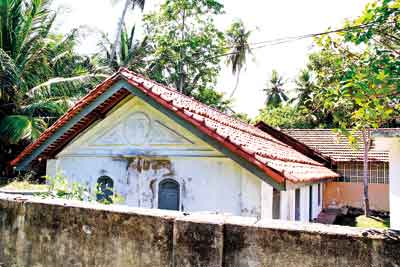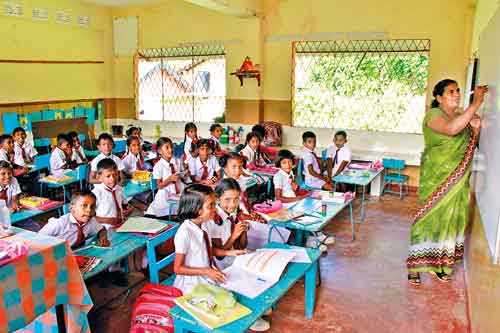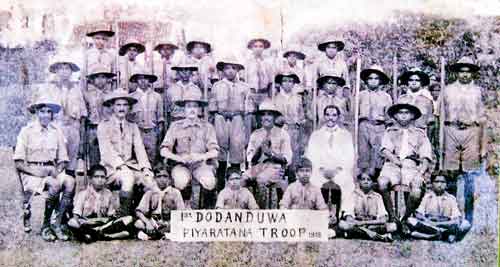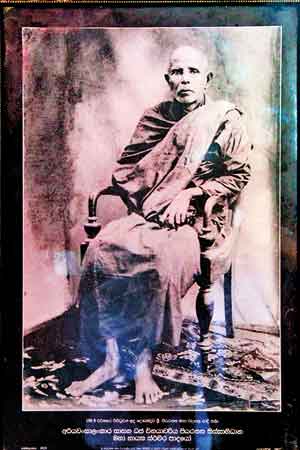A forgotten chapter in Buddhist education

Principal- Chandrika Samanmali
The shell of a school building adorned with a swastika symbol still stands, the few remaining chairs and tables awaiting the footfall of youngsters. The school laboratory, once the pride of the South is a store room. As if in a mismatch of architecture, parallel to the colonial-looking buildings, a new single storeyed block shelters five classrooms, 157 children and a tutorial staff of seven. Raised concrete beams tell of a long awaited upper floor…
The vision of Sri Dhammasara Piyaratana Maha Vidyalaya in Dodanduwa proclaims: ‘to mould a generation of responsible citizens replete with skills, values, discipline and wisdom.’ Once a respected institution of learning which produced scientists and academics, this first Sinhala Buddhist school in the country established by Ven. Sasanalankara Vinayacharya Siri Piyaratana Tissa Nayake Thera in 1869 is a heart-wrenching sight today. Yet despite the odds, present Principal S.L. Chandrika Samanmali, who took over in 2013, is honoured to be at its helm.
“There are only five classes today- from Grade 1 to 5 and many children in the area seek better-equipped schools in Galle,” says Ms. Samanmali who bemoans that the school which had up to O/L classes and one of the best school laboratories in the South, Sri Dhammasara Piyaratana Maha Vidyalaya is today struggling for survival.

One of the oldest buildings now in shambles
In its heyday, the school had teachers coming from Jaffna and from time to time even from India, she says. Villagers recall that the railway track which runs next to the school used to be overrun by white uniforms till the school bell was rung. “Ada rail para palui,” (today the rail track is deserted)” is the common lament of the Dodanduwa folk. The original buildings which mirror colonial architecture are dilapidated, some left to the mercy of nature’s elements. The only one spared proclaims that it’s conserved by the Archaeology Department. Sadly, no children fill the building.
As we step into the Grade 4 classroom of Renuka Damayanthi, eager little faces smile at us, a few giggles are heard, some are camera-shy and others boldly facing it. A mathematics lesson is in progress and chirpy voices unite in crescendo. In the adjoining Grade 5 classroom a scientific experiment on ‘light’ takes place oblivious to the science lab the school once boasted of. The staff are valiant in their efforts even though lacking basic facilities like a telephone and computer.
“If we could at least open the path for these children to enter a city school, we will be successful,” reflects the Principal. The school currently prepares students for the Grade 5 scholarship exam.
Born to the Weerasuriya family of Dodanduwa on December 12, 1826, Ven. Siri Piyaratana Tissa Nayake Thera

A class in progress. Pix by Indika Handuwala
was ordained at the age of nine at Sailabimbaramaya under Ven. Koggala Susammata Dhammasara Thera, the Chief Incumbent of the Vihara. Inaugurating the Lokartha Sadhaka Samagama, Piyaratana Thera set up the first Buddhist school in the island in 1869 in Dodanduwa. The school which was located in the premises of the Sailabimbaramaya, was then called Jinalabdhi Visodhaka Patashawala, though popularly known as Dodanduwa School. This was the beginning of the Buddhist education movement to counter the Christian challenge, even before Colonel Olcott set foot in the island.
Several philanthropists in the area had rallied round the visionary prelate to fund the school. Sourcing text books however had been a challenge and the learned prelate had prepared two readers- Neyyartha Dipani and the Jina Dharma Vikasini, dealing with the life of the Buddha and Buddhist ideals and principles of lay life. He had also prepared a school reader.
Given the great hesitancy by the British to register Buddhist schools during this time, it was only in 1874 the school was registered, says the present Chief Priest of Sailabimbaramaya, Ven. Dewuramvehera Medhalankara Thera. “It is said that on Governor Robinson’s first official visit to Galle, the villagers had given him a grand welcome and also handed over a petition to him urging the British Government to acknowledge the school.” After the demise of Piyaratana Thera in 1907, the administration of Jinalabdhi Visodhaka Patashawala was taken over by Ven. Dodanduwe Dhammissara Thera who later initiated an English Buddhist school in the Sailabimbaramaya premises which came to be known as Piyaratana English School of Dodanduwa. “The two schools were later amalgamated and renamed Sri Dhammasara Piyaratana Maha Vidyalaya in honour of Piyaratana Thera and his guru Koggala Dhammasara Thera,” notes Ven. Medhalankara Thera.

Proud scout troop of 1918
The temple which is more than 200 years old is a repository of historical documents including several letters exchanged between Piyaratana Thera and Colonel Olcott and is conserved by the Central Cultural Fund today. Prof. M.B. Ariyapala in ‘Cultural Renaissance- a lesser known pioneer Ven. Piyaratana Tissa Maha Thera (Journal of the Royal Asiatic Society, Sri Lanka Branch, Volume XXV) refers to some of these letters and implies that Piyaratana Thera and Colonel Olcott had been pen friends for a while. In response to a letter in which the prelate extends an invitation to Colonel Olcott, the latter says: ‘the hand of welcome you extend to us is most cordially and warmly grasped.’
The arrival of Colonel Olcott in the island in 1800 was a turning point. Meeting Piyaratana Thera in Dodanduwa propelled Colonel Olcott to form the Buddhist Theosophical Society in Sri Lanka which assisted in establishing many leading Buddhist schools such as Ananda College, Colombo, Mahinda College, Galle, Musaeus College, Colombo and Dharmaraja College, Kandy. Colonel Olcott who continued to pledge his support towards Dodanduwa School, had also donated valuable equipment to the school. The projector with 8 mm Kodak films, he had donated to the school had been sold for a ‘pittance’ several years ago to a private party as the chief prelate of Sailabimbaramaya informs us. The decline of this school, the monk attributes to ill administration by school authorities and absence of political will to revive it.

The founder: Ven. Piyaratana Thera
A few English classics in the library speak for its one time glory. A fading photograph of a Scout troop dating back to 1918 is evidence of the rounded education the institution once provided. The present staff does their best with annual activities including the alms giving in memory of the founder, perahera and bhakthi gee.
Prof. W.M. Karunadasa, former professor of International Relations at the Colombo University and a distinguished past pupil of the school recollects that during the 1940s and 1950s Sri Dhammasara Piyaratana Maha Vidyalaya was a “competitive school” where admission was not easy. “Children as far as from Galle, Boossa, Telwatta, Rathgama and Ambalangoda sought admission to this school and there were science teachers coming from India such as Mr. Jacob who taught us for our O/Ls.” Science stream students did experiments in one of the best Southern labs and drew inspiration from erudite quotes which once adorned every school wall, he recalls, adding that students received a good education. “I headed the debating team of the school and also the Literary Society,” he says.
Chartered Architect and Town Planner, Dr. Dayananda Waduge, an English-medium Science student of the school in the late 1940s recollects being a drama enthusiast. “During my times, there were classes up to the O/Ls and for my A/Ls I left to Mahinda College, Galle. However, there had been a time when the school had prepared students for Cambridge Senior Examination,” says Dr. Waduge, who like all his contemporaries laments the school’s present state.
Sri Dhammasara Piyaratana Maha Vidyalaya is nearing its 150th milestone. According to late Prof. Gunapala Malalasekera, it is also the first Buddhist school to be established in the world. Prof. M.B. Ariyapala recollects: “Prof. Malalasekera made this statement from the Chair when he addressed those assembled to celebrate the centenary of the school in 1969, which I myself had the opportunity of attending.’ (Journal of the Royal Asiatic Society, Sri Lanka Branch, Volume XXV)
The first ever Buddhist school in the country which paved the way for many other leading Buddhist schools, simply does not deserve to be in oblivion as it is today. An urgent effort is called for to renovate and conserve this historic seat of learning.


